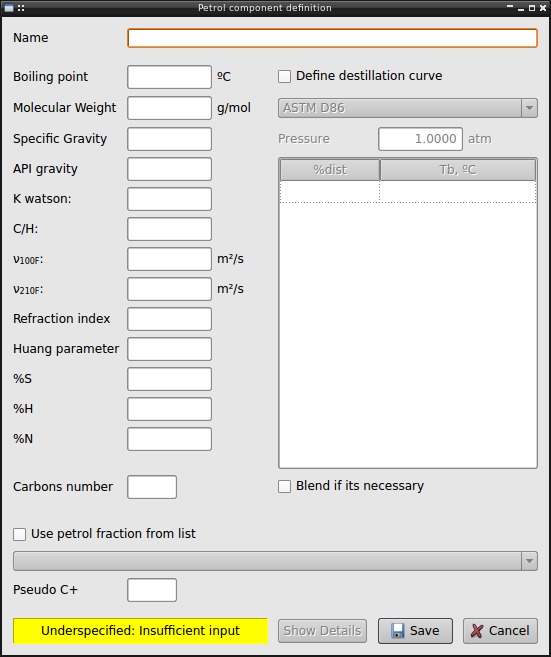Defining custom components
If you want to use a component the database dont have you can define your custom components. Thas new component can be save in custom database and can used in whatever project you want. There are several methods to define custom component.
Define new component
You can define a new component specified the properties available, using the menu option Tools/New Component/Component. It must specified some minimum properties as Tc, Pc and ideal gas specific heat coefficient, other data and opcional, pychemqt can stimated it, but if we have that data we might input to improve prediction.
The correlation data can be calculated if we have the experimental data using the regression button  . Regression equation limited to DIPPR common correlation
. Regression equation limited to DIPPR common correlation
- Y = A+B*T+C*T²+D*T³+E*T⁴
- Y = exp(A+B*T+C*ln(T)+D*T^E)
- Y = A*T^(B/(1+C*T+D*T^2))
- Y = A+B*exp(-C/T^D)
- Y = A + B/T + C/T³ + D/T⁸ + E/T⁹
- Y = A/(B^(1+(1-T/C)^D)
- Y = A*(1-Tr)^(B+C*Tr+D*Tr²+E*Tr³)
- Y = A+ B*((C/T)/sinh(C/T))² + D*((E/T)/cosh(E/T))²
- Y = A²/Tr + B - 2ACTr - ADTr² - C²Tr³/3 - CDTr⁴/2 - D²Tr⁵/5
where:
- Y Property to fit
- T temperature in Kelvin
- Tr: reduced temperature T/Tc
- A,B,C,D,E parameters
Define petro fraccion
We can too define a mixed component, as a oil fraction, with undefined composition, calculate its properties with correlations. This option is available in the menu option Tools/New Component/Pseudocomponent.

We can specified the pseudocomponent with this properties:
nombre: name of component, to recognice in database
M: molecular weight
Tb: normal boiling point
SG: specific gravity at 60ºF
API: API gravity
CH: C/H ratio
I: Huang parameter
n: Refractive index
Nc: Cambon number in fraction
Kw: watson factor
v100: kinematic viscosity at 100ºF
v210: kinematic viscosity at 210ºF
H: % hydrogen in fraction
S: % sulfur in fraction
N: % nitrogen in fraction
- Destilate curve
D86: Distribución de temperaturas de ebullición de la fracción según la norma ASTM D86
TBP: True boiling point
SD: Simulated distillation según la norma ASTM D2887
EFV: Equilibrium Flash Vaporization
- D1160: Curva específicas a baja presión
- P_dist: Presión de la curva de destilación, en mmHg
The pseudocomponent can be defined with several definition option, its priority as correlation precision is:
- Tb and SG
- M and SG
- Tb and I
- M and I
- Tb and CH
- M and CH
- v100 and I
- Nc (very rough option)
- Destilate curve
API is equivalent to SG, Kw is equivalent to SG o Tb, n is equivalent to I
Alternatively we can choose define the pseudocomponent from a crude database, in that case is only necesary specified the crude from the list.
When we have define the pseudocomponent we can see special calculate properties from it and save to database for use it in a project.
Reference:
- Ahmed, Tarek. “Equations of state and PVT analysis: applications for improved reservoir modeling.” Gulf Publising, 2007.
- Riazi, M.R. "Characterization and Properties of Petroleum Fractions." ASTM International, 2005.
- Speight, J. G. "Handbook of petroleum analysis." Wiley-Interscience, 2001.
Define from group contribution
Its possible to define a new component from contribution groups, there are several methods implemented in pychemqt:
- Joback
- Constantinou-Gani
- Wilson-Jasperson
- Marrero-Pardillo
- Elliott
- Ambrose